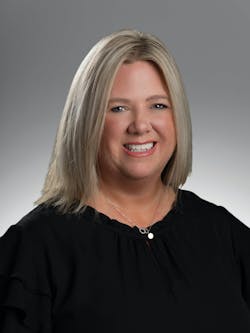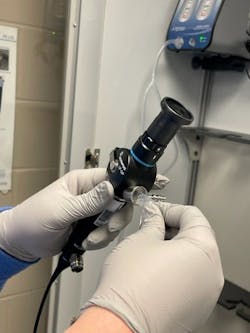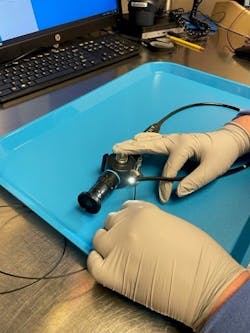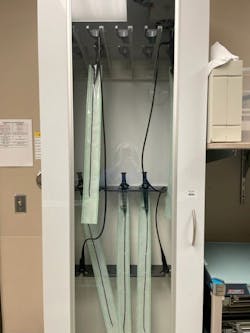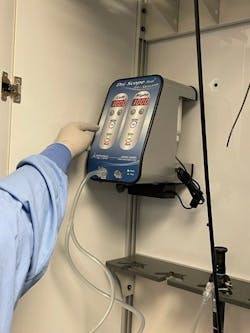Aligning on aeration, drying, storage and transport standards
As if the work of sterile processing (SP) professionals wasn’t complex enough, advances in medical and surgical technologies continue to present them with additional challenges. This is certainly the case with endoscopes and other medical/surgical devices and instruments with channels, lumens, and other hard to see/hard to reach areas.
Beyond cleaning and disinfecting these items is the challenge of aeration and drying, with U.S. guidelines recommending flexible endoscopes with channels be dried for a minimum of 10-minutes (or until no visible moisture remains).1, 2
In the typical SP department with limited instrument inventory, staffing challenges, and pressures to turn these items around quickly for subsequent procedures, 10 minutes can seem like 10 hours in the face of competing priorities.
And then there is the challenge of storing and transporting scopes and devices in a way that keeps them free from contamination.
Aeration, drying, storage and transport isn’t a new topic, but it is one that warrants further discussion. Healthcare Purchasing News (HPN) contacted SP leaders and industry experts for their insights and best practices in this area of reprocessing.
Planning ahead: the Sanford Hospital Sioux Falls story
The Sanford Hospital Sioux Falls Central Processing/Surgical Services department processes mostly bronchoscopes, nasopharyngeal scopes, and laryngoscopes for the operating room (OR) and respiratory teams, while the hospital’s GI department processes its own endoscopes.
HPN spoke with the hospital’s Lead Coordinator, Central Processing/Surgical Services Lori Buskol about her department’s scope/device aeration, drying, storage and transport processes. She described how she and her team keep up with changing standards and recommendations and offered advice to other SP teams facing similar challenges.
It pays to stay ahead
“It feels like every few months there is a small change in scope processing guidance,” said Buskol. “The more investigating they do with the scopes, they more they learn, and we must configure those learnings into practices for our team members to employ.”
The Sanford Hospital Sioux Falls SP team takes a proactive approach to endoscope processing standards. Buskol, who serves as the department’s instrumentation lead coordinator, and the quality lead coordinator, are constantly reading the latest endoscope processing recommendations and updates to manufacturer instructions for use (IFUs). She stated:
“Endoscopes has been a huge vocal point for the past couple of years and we can see these changes happening. We try to get ahead of it with our team by looking into things - what does the research show, what are industry associations saying, what do they anticipate for changes, will there be recommendations or suggestions? If they are starting to use certain verbiage, we feel we should probably take that next step and investigate it.”
“We spend so much time researching before it becomes a problem,” she added. “We find it’s very helpful because it always keeps us ahead. We want to be there and ready so when The Joint Commission visit us, they will say ‘you’re a step ahead.’ And that’s what we want to be.”
Every Monday, Buskol and the quality lead coordinator meet with their department manager and supervisor and the four of them read through all their findings, discuss whether changes in scope processing should be made, and if so, where they need to update their protocols and practices.
“If we find a potential change that must be made, we start testing out the change ourselves to determine if we need new equipment or supplies,” Buskol explained. “Then our manager presents our findings to the hospital executive team so they provide the resources for us to adapt processes to implement changes, order the necessary supplies and equipment, and develop the documentation behind why we should be doing it.”
Putting planning into practice
Sanford Hospital Sioux Falls SP team’s work to stay ahead has been demonstrated in their scope aeration, drying, storage and transport processes, which align with ANSI/AAMI ST91:2021, Flexible and semi-rigid endoscope processing in health care facilities.
Aeration and Drying
ANSI/AAMI ST91:2021 emphasizes how the channels of high-level disinfected endoscopes must be dry before storage to help prevent bacterial growth and the formation of biofilm. The standards cite the preference for methods that employ active drying of endoscopes with filtered air, noting how some storage cabinets can be used to both secure processed scopes and circulate air through them.
Sanford Hospital Sioux Falls has a scope drying cabinet in its SP department, and alongside it Buskol and her team have developed tools to guide technicians on best practices for using it.
“We provide users documentation on every scope that we receive in our area as to what size tubing and connectors it requires. That way, team members know exactly what to use for each specific scope when hooking it up in the cabinet for the 10-minute dry cycle.”
Inspection and testing
ANSI/AAMI ST91:2021 noted that if a drying cabinet is not used, dryness can be checked by using dryness indicators. The Sanford Hospital Sioux Falls SP team covers all its bases by using these indicators to test following the drying cycle.
“Each day we perform a test on all our scopes to ensure they are dry, and we have our calibration set up correctly,” said Buskol. “This is done by putting colored paper made for the purpose on the distal end of the scope, which reveals whether there is any residual moisture.”
Per ANSI/AAMI ST91:2021 visual inspection recommendations, the team employs lighted magnification and borescopes to inspect processed endoscopes. Starting with just one borescope used for cannulated orthopedic instrumentation, the fleet has now grown into 10 borescopes located in decontamination, the scope room and every assembly station.
As with every step of scope processing, reinforcing best practices is critical in the inspection process. Because there can be confusion among technicians as to which scopes should be inspected with lighted magnification versus borescope, Buskol has developed a guidance document that technicians can easily access and understand. She commented:
“Some bronchoscopes and nasopharyngeal scopes have very small lumens, and our borescopes go down to just 2mm inside. We want to avoid someone trying to force a borescope down a lumen when it may not fit because they will harm the scope. To clear up any confusion, we’ve developed a list of all our scopes, their part/model numbers, what size brushes and swabs should be used and whether inspection should be performed with lighted magnification or a borescope.”
Storage
ANSI/AAMI ST91:2021 emphasizes the importance of proper scope storage in both protecting scopes from contamination and damage, and identifying those that are “patient ready” as opposed to those that have not been processed with liquid chemical sterilants (LCSs) or high-level disinfectants (HLDs).
Sanford Hospital Sioux Falls employs a two-cabinet process for storage, with one dry scope cabinet in the SP department and the other in the operating room (OR) clean core, as Buskol explained:
“That way, we always keep them hanging and aerating to ensure they stay clean and dry. Furthermore, with the two-cabinet process, everyone knows where the scopes are stored, as opposed to storing them in a cart that could end up somewhere they can’t easily find them.”
Transport
“Scope transportation was our biggest, most difficult process,” said Buskol. “Because we are in the basement with the OR two floors above us, we had to map out all the touchpoints in the transport process and opportunities for recontamination of clean scopes.”
With the two-cabinet process, transport is relatively simple. Using closed containers, the SP team transports the scopes to the cabinet in the OR core and hangs them there. The challenge is keeping the scopes clean during handling.
Hand hygiene and use of personal protective equipment (PPE) are highlighted in ANSI/AAMI ST91:2021, noting how users should don new, clean, non-latex gloves immediately before removing an endoscope from the storage cabinet. Buskol and her team have put into place processes to help drive compliant scope handling.
“We have gloves attached to the dry cabinet for staff to don before removing a scope,” said Buskol. “We also have sani wipes so they can clean surfaces, such as the cabinet handles, after touching them.”
In fact, Buskol emphasizes the importance of hand hygiene to the team throughout each step of scope processing. When developing their standard processes, she met with the hospital’s infection control practitioner, and they determined at what points in each process staff members should don a new pair of clean gloves. Buskol translated this into practice by placing hand symbols in printed staff guidance documents to clearly indicate when it’s time for a glove change.
Advice to others
When asked what advice she has for other SP teams in driving scope aeration, drying, storage and transport best practices, Buskol stated:
“If you want to be prepared and don’t want to end up under the wire when scope processing guidance changes again make sure to constantly do your research. If one of the standards bodies suggests a new practice, expect that it’s likely to become a recommendation in the future. And then trial it.”
“When a new suggested practice arises, we establish our process and supporting documents, watch someone unfamiliar with the process try to complete it, grade their success and if they have problems change the process/documents accordingly.”
“Because remember, those of us in department leadership positions can’t possibly be at each team member’s side each time they perform a task to answer their questions. Therefore, you need to provide them with tools that detail each step so they can troubleshoot on their own.”
References:
1. ANSI/AAMI ST91:2021 Comprehensive guide to flexible and semi-rigid endoscope processing in health care facilities
2. Association of periOperative Registered Nurses (AORN) revised Guideline for Processing Flexible Endoscopes
Industry insights on the topic
Endoscope manufacturers and processing equipment suppliers offered their advice on scope aeration, drying, storage and transport, including how to make the case to hospital leaders for investments in these processes:
Doug Brown, Director of Sales & Marketing, Torvan Medical
“Research drying of endoscopes. There is a lot of excellent data out there from key opinion leaders on the clinical necessity for it. The same can be said for borescopes. You can also show an ROI for a scope drying cabinet by citing standards that state an endoscope stored in a proper endoscope drying cabinet, in a lot of cases for up to 7 days, does not need to be reprocessed again prior to a procedure, where a scope not properly dried needs to be reprocessed again before a procedure. There is not only a cost savings on unnecessary reprocessing, but also on the wear and tear on an endoscope caused by repeated reprocessing.”
Ann Hewitt, Vice President of Sales and Marketing, Cenorin
“There are compelling financial and infection prevention reasons for thoroughly drying devices when they come out of an automated washer-disinfector. Many SP staff are familiar with the potential for cancelled low-temperature sterilization cycles when moisture is detected. They recognize that the cost to re-clean, re-disinfect, re-dry and re-package the contents of that load added to the cost of using an additional container of sterilant is considerable, in both materials and labor. Completely dry instruments would prevent these cancellations.”
“They also prevent moisture-related issues in the OR. No one wants to hear from the OR that there was a strike-through, or that a robotic arm has droplets coming out of it. The cost to carry additional inventory for replacement when there is a moisture-related event coupled with the wait-time for the OR is relatively high. Decreasing inventory and increasing OR readiness and satisfaction are ample reasons to improve instrument drying.”
Richard Radford, CEO, Cenorin
“The same could be said about washer/thermal high-level disinfectors (pasteurizers). Many hospitals are reviewing the use of single patient use (SPU) plastic devices and switching to reusable devices. All these devices involve cleaning and exposure to water and require drying to safely complete the process for safe next use.”
Eric S. Smith, Infection Prevention & Control Specialist, Olympus
“Take the time to lay out and visually understand your reprocessing/sterile processing flow and identify where drying/storage/transport fits. Most guidelines recommend assigning designated physical space for functions such as drying/storage. It’s important to understand how much space is available to perform that function, which may impact your review process and next steps.”
“It’s also important to understand the number of procedures being performed vs. the number of devices that need to be dried/stored/transported. Take that a step further and identify the number of devices that need to be dried/stored/transported per hour/per day to meet your procedure volume. This will help you understand the number of drying devices your facility needs and may impact the purchase you make.”

Kara Nadeau | Senior Contributing Editor
Kara Nadeau is Sterile Processing Editor for Healthcare Purchasing News.

